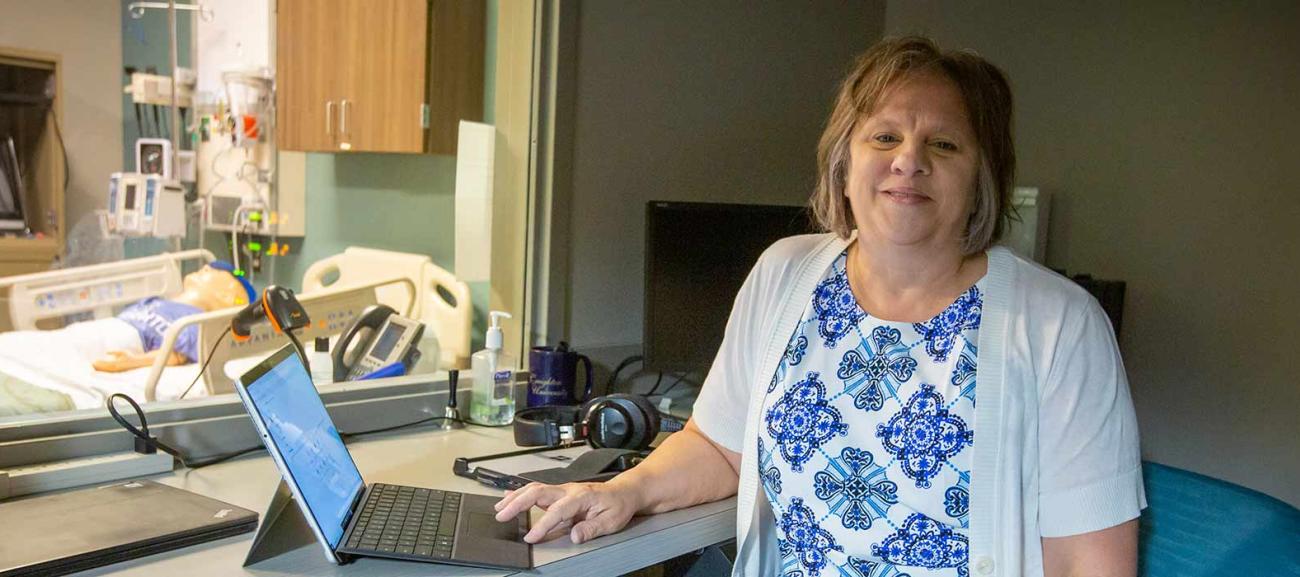
New O’Brien chair founded game-changing nursing assessment tool

In 2008, Martha Todd, PhD, MS’07, had an idea. That idea has since spread the name of Creighton University and its College of Nursing throughout all 50 states, across 32 nations and has been translated into 16 languages, including Chinese.
Fourteen years later, it’s time for an update, and perhaps a slightly more entrepreneurial approach to a tool that at its creation seemed no more than a comradely contribution to nursing education.
The Creighton Competency Evaluation Instrument, or C-CEI, is basically a single-page checklist in which the skills students must master to prove competence in nursing are distilled into four categories and 22 nursing behaviors.
Todd, who was recently named the O’Brien Endowed Chair in Health Sciences at Creighton, says the C-CEI was born just as technologically advanced mannikins were enhancing the role of simulation in nursing education.
It seemed to her, and to Julie Manz, PhD, BSN’98, MS’05, who was also present at the creation, that while these sophisticated mannikins provided a transformative experience in an environment where mistakes could safely be made, there existed no reliable method for assessing how well students were learning their lessons. Thus was born the C-CEI and its concise single-page assessment.
“What Martha really envisioned was a broader way to assess nursing student performance using all the things that nurses do,” Manz says.
“There is a lot more to assessment than just proving your ability to insert an IV. For example, taking in all the data when you walk into a room, communicating and interacting with other providers, interacting with the patient and with the family. Critical thinking. How do we use our reasoning to solve problems with the patient and help the patient get to the other side of this? All these skills need to be assessed.”
And all this, the single-page C-CEI did, checking a “1” when competency was demonstrated and a “0” when it was not. Knowing that they were being graded on their interactions with the mannikins did wonders for student concentration, Manz says.
An article describing what Todd and Manz call their “instrument” was promptly published in the International Journal of Nursing Education and Scholarship, and the two women considered their duty done.
“Then it blew up,” Todd recalls. “They reached out to us from the National Council of State Boards of Nursing, which is the bigwig of nursing where everybody goes to get licensed.”
Policy Formation at the National Level
The council was trying to understand the degree to which simulation could replace direct clinical experience with real patients on actual hospital wards. They wanted to use the C-CEI to conduct a major national survey, which resulted in 30,000 uses of the tool.
“So, our instrument became a big player in the area of policy formation on the national level,” Todd says.
Skip now to 2022 and nursing education is moving toward competency-based assessment, defined by the National Institutes of Health as “the knowledge, skills, ability and behaviors that a person possesses in order to perform tasks correctly and skillfully.”
“Well, lo and behold, our Creighton competency instrument can assess student performance,” Todd says. “So, we think we are rolling into a perfect storm.”
Still, given that 14 years have elapsed since Todd, Manz and their team first launched the C-CEI, and given that the American Association of Colleges of Nursing now identifies 240 competencies that must be demonstrated by nursing graduates, Todd and Manz say the C-CEI is feeling “dusty” and needs both updating and a greater technological sophistication.
Building a C-CEI App
“We are in the midst of building a C-CEI app,” Manz says, “and we would like to maintain a website where we can post updates and training videos. The instrument is so different from other training tools that it really needs a robust training cycle.”
But that will take money, and profit was not a consideration when Todd and Manz first launched their creation.
“We had no idea that anybody would be interested,” Manz says. “So, we never did address things like copyright or intellectual property or licensing. We learned all these lessons along the way because we just didn’t know any better.
“None of us were in it for money, and we didn’t expect that it would take off the way that it did. We’re still not interested in making money, but we are interested perhaps in charging something so that we can at least maintain an app or a website, to keep things moving forward.”
And, of course, being teachers first and last, Todd and Manz hope to structure their revised C-CEI so that nurses or nursing institutions that purchase it might receive continuing education credits for mastering its use.
“You know, education is typically not well funded, and so while we recognize that we have a good product, we need revenue to take it to a different level,” Todd says.












